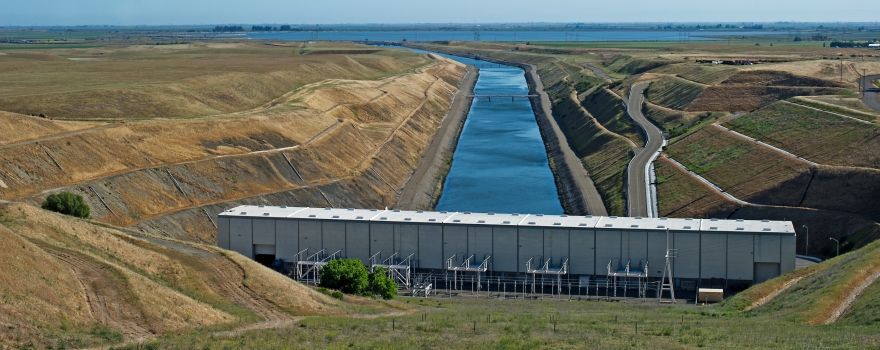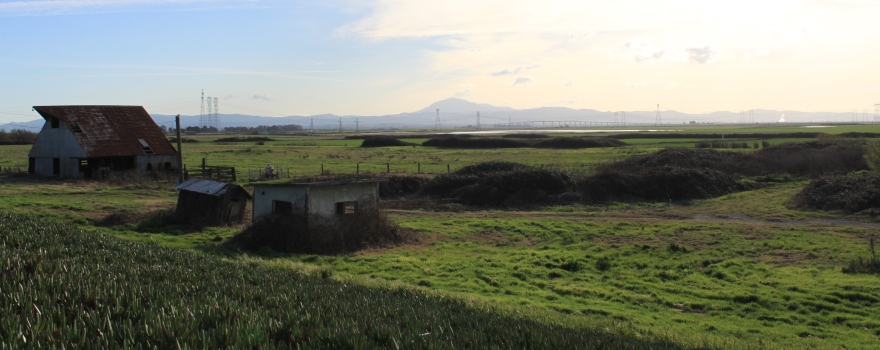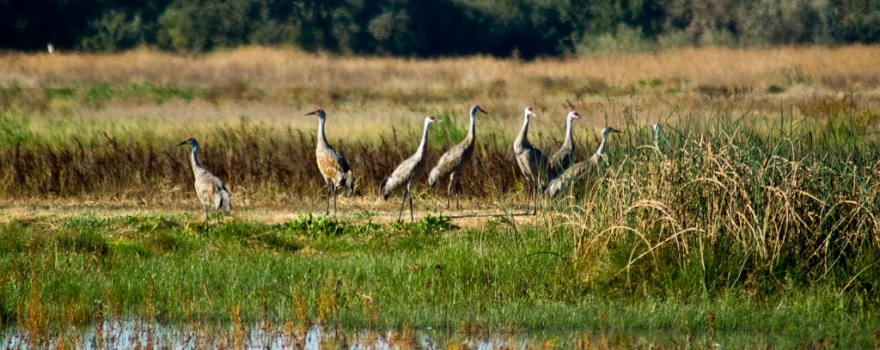The plan to build a canal or a tunnel to move water around the Delta instead of through it is nothing new. The roots of the idea go back to the 1970s. Though long sought by water interests, the project remains as controversial as ever.
This page last updated on February 7, 2021.
Trans-Delta System, Peripheral Canal, Bay Delta Conservation Plan, California Water Fix, and now, the Delta Conveyance Project – the idea of a canal to route water around the Delta is certainly not new. It was originally thought of as part of the master plan for the State Water Project, but wasn’t included in the initial construction due to cost considerations. In the 1980s, plans were begun to construct such a canal, but it was put to a statewide vote, which was soundly defeated.
But the idea did not end there. Over the years, building some sort of bypass around the Delta has continued to be discussed intermittently despite setbacks and strong opposition, which seems largely decided by geography, with more opponents found in the northern part of the state with the most vocal perhaps from within the Delta itself.
Project proponents assert that such a project is needed to shore up the water supplies critical for the state’s economy and that the new infrastructure will benefit the Delta’s ailing ecosystem and native species by utilizing state-of-the-art technology and allowing for more natural flow patterns. Delta advocates insist the Plan is too expensive and say that the new facilities will deprive the estuary of needed freshwater flows that will only hasten the collapse of the Delta’s ecosystem and native fish populations.
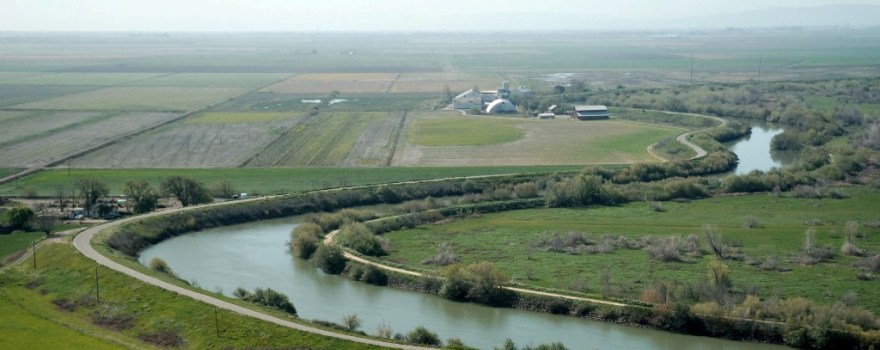 Fixing the Delta – a vexing problem
Fixing the Delta – a vexing problem
The Delta is many things to many people: a magnificent estuary, fertile and productive agricultural lands, a popular recreation spot – it is also the hub of the state’s water system and the center of the water debate for decades. Despite many failed attempts to address the Delta’s issues, today the Delta is undeniably in a state of crisis, as evidenced by plummeting populations of several of the Delta’s threatened and endangered fish species, some to new historic lows.  Debate rages on about the causes: is it water exports, altered flows, loss of habitat, contaminants, harmful non-native species, or something else? Add to that, some question whether the Delta’s levees can withstand earthquakes or strong storms, and the rising sea levels and other climate change impacts only add to the disputes. (For a pictorial look at this complicated place, check out this slideshow.)
Debate rages on about the causes: is it water exports, altered flows, loss of habitat, contaminants, harmful non-native species, or something else? Add to that, some question whether the Delta’s levees can withstand earthquakes or strong storms, and the rising sea levels and other climate change impacts only add to the disputes. (For a pictorial look at this complicated place, check out this slideshow.)
Many (but not all) of the Delta’s current problems can be attributed to the southern location of the facilities that draw in water for the state and federal projects.
But when the project pumps are in operation, they actually create ‘reverse flows’ that pull the water southward towards the pumps, rather than allowing it to flow out towards the San Francisco Bay. These reverse flows adversely affect salmon migration patterns and impact many fish species by pulling them towards the intake facilities where they can be subject to predation or entrainment in the pumps. In an attempt to reduce the impacts on fisheries, in recent years, regulators have limited the amount of water the state and federal projects can export from the Delta.

The facilities planned for the Delta Conveyance Project are intended to alleviate this problem; by diverting water from the north Delta, a more natural direction of river flows would be reinstated, and fish would be protected by state-of-the-art fish screens.
However, it is the diversion of water from the north Delta that is one of the main points of controversy (although there are others): Delta advocates say that diverting the water before it can flow through the Delta will only deprive the estuary of needed freshwater flows, worsen water quality for farmers and residents, and drive native species to extinction. Project proponents counter that the new state-of-the-art facilities will improve environmental conditions and be more protective of fish, and new operating criteria will protect spring outflow and Sacramento River flows. Delta stakeholders are wary that protective criteria will be overridden if it means less water can be exported. The science and the modeling are uncertain, and so the debate rages on.
 The Bay Delta Conservation Plan was born
The Bay Delta Conservation Plan was born
The roots of the most recent Delta Conveyance Project extend back to the Bay Delta Conservation Plan, which began in 2006 under the Schwarzenegger Administration. At the time, the Department of Water Resources, the Bureau of Reclamation, and several state and federal water contractors proposed taking a habitat conservation planning approach that would provide for new water infrastructure facilities while at the same time, pursuing large-scale restoration and other activities to benefit the Delta’s ecosystem as a whole. The Bay Delta Conservation Plan (or BDCP) would comply with endangered species regulations by seeking permits as a Habitat Conservation Plan under federal endangered species regulations and as a Natural Communities Conservation Plan (NCCP) under state endangered species regulations.
 A habitat conservation planning approach sets a higher standard for the protection of species and habitat than the traditional biological opinion approach; habitat conservation plans are designed to recover listed species to the point where they no longer need to be listed, and to prevent the possible listing of other species. It is often viewed as a preferable to the single-species biological opinion approach as a conservation plan is implemented on a landscape-level allowing multiple species and multiple issues to be addressed. Developed in the mid 1990s, habitat conservation plans have most often been used for urban development in open spaces that sets aside habitat for species while also allowing development to occur; the Bay Delta Conservation Plan was the first time the habitat conservation planning process was being attempted on such a large-scale for an aquatic ecosystem.
A habitat conservation planning approach sets a higher standard for the protection of species and habitat than the traditional biological opinion approach; habitat conservation plans are designed to recover listed species to the point where they no longer need to be listed, and to prevent the possible listing of other species. It is often viewed as a preferable to the single-species biological opinion approach as a conservation plan is implemented on a landscape-level allowing multiple species and multiple issues to be addressed. Developed in the mid 1990s, habitat conservation plans have most often been used for urban development in open spaces that sets aside habitat for species while also allowing development to occur; the Bay Delta Conservation Plan was the first time the habitat conservation planning process was being attempted on such a large-scale for an aquatic ecosystem.
Habitat conservation plans require additional actions to benefit covered species and aid in their recovery; they are therefore more costly to implement. However, the benefit of these plans is that if they are approved, long-term permits are issued which include regulatory assurances. Sometimes referred to as ‘no-surprises,’ these regulatory assurances essentially mean that if everything is to be implemented as specified in the approved plan and unforeseen circumstances occurred that adversely affected a covered species, no additional compensation or restrictions are placed on the project. These regulatory assurances are one of the main incentives for project proponents to take on the added cost and extra effort of the habitat conservation planning process.
 In December of 2013, the agencies released the draft habitat conservation plan documents and their associated draft environmental documents – a massive 40,000 pages – with the public review period closing at the end of July, 2014. During the six month comment period, over 12,000 comments were received from other state and federal agencies, environmental groups, organizations, and stakeholders; reviews were mixed, at best.
In December of 2013, the agencies released the draft habitat conservation plan documents and their associated draft environmental documents – a massive 40,000 pages – with the public review period closing at the end of July, 2014. During the six month comment period, over 12,000 comments were received from other state and federal agencies, environmental groups, organizations, and stakeholders; reviews were mixed, at best.
There were concerns expressed about the effectiveness of tidal marsh restoration, especially given the plan’s reliance on significant amounts of habitat restoration for ecosystem recovery. Many expressed concern over the length of the permit term, saying there was just too much uncertainty to issue permits with regulatory assurances for 50 years. Concerns were expressed by the EPA and others that the project would likely increase salinity and contaminant levels within the Delta, providing better water quality for export from the Delta at the expense of the farmers and municipalities that draw their supplies directly from it. Others expressed concerns that the impacts of the project both upstream of the Delta and downstream in the San Francisco Bay were not analyzed. Still other commenters expressed concerns about the modeling, construction impacts, and how climate change was being incorporated.
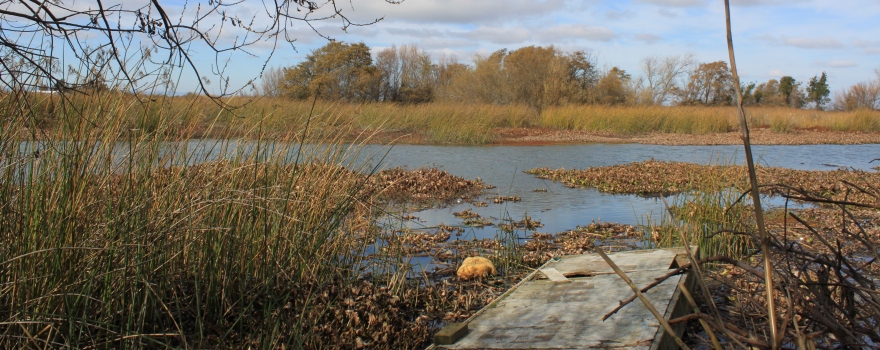 Bay Delta Conservation Plan morphs into the California Water Fix
Bay Delta Conservation Plan morphs into the California Water Fix
In December of 2014 in response to the comments received, the lead agencies announced major design changes to the project; however, these changes would not prove enough to overcome the uncertainty that the project could be permitted under a habitat conservation planning approach, and so in April of 2015, Governor Brown announced that the project would return to the more traditional process and seek consultation and biological opinions for the new facilities. The new water infrastructure facilities would now be called “California Water Fix”; restoration activities, greatly downscaled to about one-third of the BDCP’s acreage, would be pursued separately under the “California Eco Restore” program.

In July of 2015, the Bureau of Reclamation and the Department of Water Resources released partially recirculated draft documents reflecting a return to a traditional permitting strategy. The documents analyze new alternatives that focus only the new facilities and the associated mitigation required for the impacts of the construction and operation of those facilities.
Identified in the new documents as Alternative 4A, the facilities remain much the same as its predecessor, the Bay Delta Conservation Plan’s Alternative 4; there are three 3,000 cfs intakes on the Sacramento River in the north Delta and the 2,100 acres of ecosystem restoration required for mitigation.

However, Alternative 4A does incorporate key changes, such as the reduction in power requirements by the elimination of the three pumping facilities; a reduction in construction and associated impacts on Staten Island; a reduction in water quality impacts; and the increased use of more state-owned property rather than private property. Further refinements include converting concrete sedimentation bays to earthen bays, eliminating the need for pile driving by 75% at each intake site, as well as reducing construction noise, truck trips, and the amount of concrete needed for construction.
The recirculated documents also analyzed two other alternatives: a single intake 3000-cfs facility and a 5-intake, 15,000 cfs facility. Other substantive changes were included, as well as information added in response to technical comments received on the December 2013 public review draft documents; however, only those sections where changes or modifications have been made that necessitate additional public review according to the California Environmental Quality Act (CEQA) and the National Environmental Policy Act (NEPA) were included in the recirculated documents. The final environmental documents were released on December 22, 2016.
In August of 2015, the Department of Water Resources and the Bureau of Reclamation jointly submitted a petition for change in water right permit conditions to the State Water Resources Control Board for the State Water Project and Central Valley Project to add points of diversion of water on the Sacramento River associated with the California WaterFix Project. The State Water Board held a water right hearing on the WaterFix Petition from July 2016 to October 2018.
In November of 2019, Governor Gavin Newsom was elected Governor and so the project would yet again take another turn.
California Water Fix dumped; Delta Conveyance Project emerges
“I do not support the Water Fix as currently configured. Meaning, I do not support the twin tunnels,” said Governor Gavin Newsom in his first State of the State Address. “But we can build on the important work that’s already been done. That’s why I do support a single tunnel.”
And so in the spring of 2019, the project yet again took an unexpected turn. Subsequently, the Department of Water Resources rescinded all permit applications and the environmental documents and began the planning process anew.
The reformulated Delta Conveyance Project will of course require a new environmental review process, and so accordingly, on January 15, 2020, the Department of Water Resources issued a Notice of Preparation for a Delta conveyance project, a single tunnel with a capacity from between 3,000 to 7,500 cfs. Once the scoping process is completed, the Department of Water Resources will begin the preparation of an environmental impact report that will identify potential significant impacts and identify ways to avoid or reduce those impacts, mitigate when feasible, and analyze alternatives. There will be additional analysis, studies, surveys, and data to collect the information needed for the agency to analyze potential environmental impacts.
The Department of Water Resources will then issue a draft Environmental Impact Report that will detail all the potential environmental impacts that could occur with the proposed project, as well as alternatives. There will be a public review and comment period; other agencies will also comment on the draft EIR. The Department will ultimately issue a final Environmental Impact Statement.
The Delta Conveyance Project is being led by the Delta Conveyance Design and Construction Authority, a joint powers authority created by public water agencies to oversee the design and construction of the new conveyance system. The Department of Water Resources will oversee the planning effort with the cost of the project anticipated to be largely paid by public water agencies.
At this time, involvement from the federal Central Valley Project isn’t really known, and thus the variance in capacity, although likely other interested water agencies would be interested in any excess capacity. At 7,500 cfs, this Delta Conveyance Project proposes to export less water from the Delta as its predecessor, the California Water Fix, which was proposing 9,000 cfs, and even less than earlier concepts for the project.
PROJECT SUPPORTERS AND OPPONENTS
Main groups in support of the project are Californians for Water Security, the State Water Contractors, and the Southern California Water Committee. However, opposition to the project remains strong. Main opponents are Restore the Delta, Friends of the River, the California Sportsfishing Protection Alliance, the California Water Impact Network (C-WIN), among others. Other groups propose different conveyance options, such as the NRDC’s smaller 3000 cfs tunnel portfolio concept, the Environmental Water Caucus’s Plan B, or Bob Pyke’s Western Delta Intakes Concept; there are other proposals as well.
Maven’s Notebook (and by extension, Maven) have no opinion on the Delta tunnels project, and instead encourages readers to investigate both sides of the information and make their own decision.
Endangered species and water project operations
The Central Valley Project facilities began drawing water from the south Delta in the 1940s; the State Water Project facilities were completed 20 years later. These facilities were engineered and built at a time when the environment and species were not a societal concern; they operated unimpeded by environmental regulations until the Clean Water Act, Endangered Species Act, and other environmental laws were enacted in the 1970s. These new laws made protection of the ecosystem an explicit obligation for the state and federal water projects, and today, these facilities are operated by a complex set regulations and restrictions that govern how, when, and how much water can be exported from the Delta. This has reduced the amount of water that can be drawn to satisfy urban and agricultural demands.
 In order to comply with federal endangered species regulations, a federal agency such as the Bureau of Reclamation must consult with the federal fish agencies to determine whether planned activities will likely jeopardize a listed species or damage critical habitat; the fish agencies then issue a biological opinion. If it is determined the planned activities won’t affect listed species, a ‘no-jeopardy’ opinion is issued, allowing the activities to proceed; if the fish agencies determine planned activities would harm listed species, a jeopardy opinion is issued which includes steps the agency must take to avoid extinction of a species. Reconsultation is initiated when the amount of ‘take’ of species allowed in the permit is exceeded, new information is received on the project’s impacts, substantial modification of the project or action, or a new species becomes listed. (More on the consultation and biological opinion process here.)
In order to comply with federal endangered species regulations, a federal agency such as the Bureau of Reclamation must consult with the federal fish agencies to determine whether planned activities will likely jeopardize a listed species or damage critical habitat; the fish agencies then issue a biological opinion. If it is determined the planned activities won’t affect listed species, a ‘no-jeopardy’ opinion is issued, allowing the activities to proceed; if the fish agencies determine planned activities would harm listed species, a jeopardy opinion is issued which includes steps the agency must take to avoid extinction of a species. Reconsultation is initiated when the amount of ‘take’ of species allowed in the permit is exceeded, new information is received on the project’s impacts, substantial modification of the project or action, or a new species becomes listed. (More on the consultation and biological opinion process here.)
In the early 2000s, the Bureau of Reclamation went through the consultation process as required, but the resulting biological opinions for Delta smelt and salmon were challenged in court, found to be inadequate for various reasons, and ordered to be rewritten. The case was appealed, and the biological opinions upheld. Those biological opinions mandated requirements on federal and state water project operations to protect endangered species.
In August 2016, Reclamation and DWR requested reinitiation of consultation on long-term, system-wide operations of the CVP and the SWP based on new information related to multiple years of drought, species decline, and related data. The changed operational plan reflected a shift to pumping based on real-time monitoring rather than calendar-based targets, as well as updated science and monitoring information and a revised plan for cold water management and releases at Shasta Dam. The document stated that habitat restoration, introduction of hatchery-bred Delta smelt, and other non-operational activities would also be implemented.
In October of 2019, the new biological opinions were released. In contrast to previously issued biological opinions, the federal agencies concluded that Reclamation’s proposed operations would not jeopardize threatened or endangered species nor adversely modify their designated critical habitat. In coming to these conclusions, the US Fish and Wildlife Service and the National Marine Fisheries Service asserted that they worked with Reclamation to modify the proposed action to reduce potential threats to the species and their critical habitat and to increase mitigation measures such as habitat restoration to support listed species.
Meanwhile, the Department of Water Resources decided to obtain coverage for SWP operations under CESA by applying for its own permit from the Department of Fish and Wildlife, rather than by securing a consistency determination based on federal biological opinions issued by federal regulatory agencies, in part as a response by President Trump’s 2018 memorandum to greatly accelerate their completion.
In November 2019, DWR issued a draft environmental impact report as required by the California Environmental Quality Act (CEQA), and after a public comment period, DWR developed and submitted an application for an ITP to DFW in December 2019. The final environmental document was certified by the Department in March of 2020, with the Department of Fish and Wildlife issuing the Incidental Take Permit on March 31, 2020.
In February of 2020, President Trump signed the new biological opinions; Governor Newsom threatened to sue and promptly did so. How the operations of the Central Valley Project and the State Water Project will be ‘harmonized’ remains to be seen.

